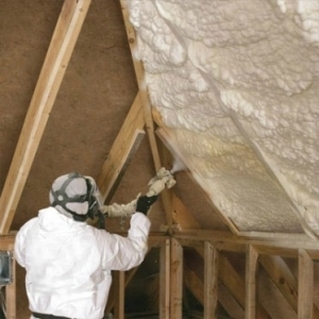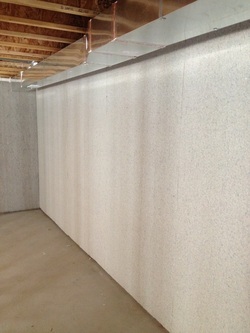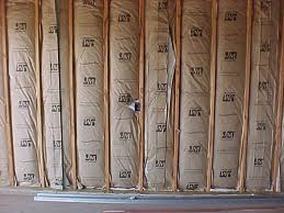Cellulose Insulation

Nu-Wool WALLSEAL system is a spray-in-place cellulose insulation product that is applied to the wall cavities of new construction. Installed to a density of 3.0 to 3.5 lbs./ft.3, WALLSEAL will not settle in the wall cavity and forms a seamless bond inside the wall cavity. Nu-Wool WALLSEAL is sprayed in place, eliminating the voids and air pockets common with other insulation materials. Density, or weight per cubic foot, which is important in reducing air infiltration and increasing
"Effective R-value", is more consistent with the Nu-Wool WALLSEAL system. The builder and the homeowner can actually see the insulation in place and know that all of the areas in a wall are insulated.
The R-value of Nu-Wool WALLSEAL is 3.8 per inch.
"Effective R-value", is more consistent with the Nu-Wool WALLSEAL system. The builder and the homeowner can actually see the insulation in place and know that all of the areas in a wall are insulated.
The R-value of Nu-Wool WALLSEAL is 3.8 per inch.
Closed Cell Foam

Closed-cell foam is where the tiny foam cells are closed and packed together. They are filled with a gas that helps the foam rise and expand and become a greater insulator. These cells can be formulated to obtain many characteristics, the most common being size and density.
Density is measured by weighing one solid cubic foot of foam material. Closed cell foam for insulation applications range in density from 1.7 lb./cu. ft. to 2.0 lb./cu. ft. Roofing applications typically use a 2.8 to 3.0+ lb./cu. ft. to support traffic and loads better. The higher the density the foam, the heavier, or stronger it becomes. Some polyurethane foams are molded into decorative interior molding and painted or stained for a simulated wood effect. These “higher density” foams are typically in the 30 lb./cu. ft. to 40 lb./cu. ft. density range.
The advantages of closed-cell foam compared to open-cell foam include its strength, higher R-value, and its greater resistance to the leakage of air or water vapor. The choice of foam can also be based on the requirements for the other performance or application specific characteristics such as strength, vapor control, available space, etc. Closed-cell SPF has an R-value of around 6.0 per inch (aged R-value) and uses high R-value blowing agents.
Density is measured by weighing one solid cubic foot of foam material. Closed cell foam for insulation applications range in density from 1.7 lb./cu. ft. to 2.0 lb./cu. ft. Roofing applications typically use a 2.8 to 3.0+ lb./cu. ft. to support traffic and loads better. The higher the density the foam, the heavier, or stronger it becomes. Some polyurethane foams are molded into decorative interior molding and painted or stained for a simulated wood effect. These “higher density” foams are typically in the 30 lb./cu. ft. to 40 lb./cu. ft. density range.
The advantages of closed-cell foam compared to open-cell foam include its strength, higher R-value, and its greater resistance to the leakage of air or water vapor. The choice of foam can also be based on the requirements for the other performance or application specific characteristics such as strength, vapor control, available space, etc. Closed-cell SPF has an R-value of around 6.0 per inch (aged R-value) and uses high R-value blowing agents.
Ecocell Batts

Cellulose Material Solutions (CMS) ECOCELL Batts, Blankets and Boards CMS products are made from a combination of renewable and recycled fibers, majority of which are post-consumer recycled newspapers, and are in most cases 100% recyclable making them the greenest products in today's marketplace. Because the material can be soft or semi-rigid, lofted or compressed, CMS materials are an innovative solution for acoustical panels, thermal batts and other molded, flat panel or lofted parts. CMS ECOCELL batts and blankets selected as Architectural Record's "Best Products of 2009". Discover the innovation at www.cmsgreen.com
Fiberglass Batts

Fiberglass Blanket (Batts and Rolls) Insulation Manufacturers now produce medium- and high-density fiberglass batt insulation products that have slightly higher R-values than previous varieties. The denser products are intended for insulating areas with limited cavity space, such as cathedral ceilings.
High-density fiberglass batts for a 2 × 4 inch (51 × 102 millimeter [mm]) stud-framed wall has an R-15 value, compared to R-11 for "low density" types. A medium-density batt offers R-13 for the same space. High-density batts for a 2 × 6 inch (51 × 152 mm) frame wall offer R-21. High-density batts for an 8.5 inch (216 mm) spaces offer about an R-30 value. R-38 for 12 inch (304 mm) spaces is also available.
One unconventional fibrous insulation product combines two types of glass, which are fused together. As the two materials cool during manufacturing, they form random curls of material. This material is less irritating and possibly safer to work with. It also requires no chemical binder to hold the batts together, and the material even comes in a perforated plastic sleeve to assist in handling.
High-density fiberglass batts for a 2 × 4 inch (51 × 102 millimeter [mm]) stud-framed wall has an R-15 value, compared to R-11 for "low density" types. A medium-density batt offers R-13 for the same space. High-density batts for a 2 × 6 inch (51 × 152 mm) frame wall offer R-21. High-density batts for an 8.5 inch (216 mm) spaces offer about an R-30 value. R-38 for 12 inch (304 mm) spaces is also available.
One unconventional fibrous insulation product combines two types of glass, which are fused together. As the two materials cool during manufacturing, they form random curls of material. This material is less irritating and possibly safer to work with. It also requires no chemical binder to hold the batts together, and the material even comes in a perforated plastic sleeve to assist in handling.

